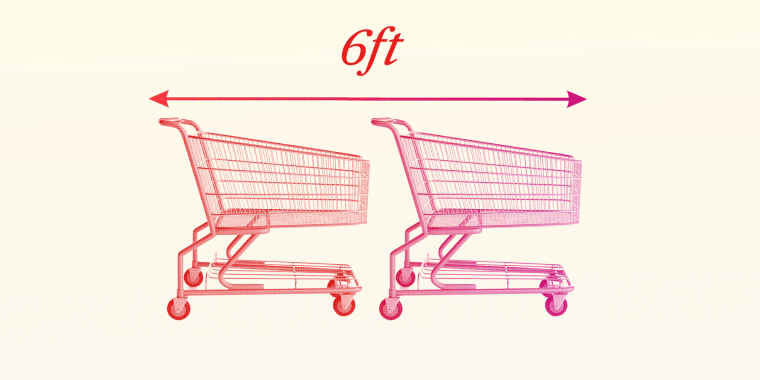When you go for a walk or to the grocery store, you don't usually bring a measuring tape with you. So how can you be sure that you're staying the necessary 6 feet away from strangers?
Here are some quick tips and visual cues to help you maintain enough social distance in daily tasks.
Stay on the other side of the sidewalk.
At a minimum, the U.S. Department of Transportation requires that sidewalks be 5 feet in width. According to the National Association of City Transportation Officials, residential sidewalks must be 5 to 7 feet wide and in urban areas 8 to 12 feet. This means that much of the time, keeping to the opposite end of the sidewalk from your pesky neighbor will provide enough space.
Should you cross the street to avoid a passerby? It depends.
If you can maintain 6 feet of distance, it's not necessary, explained Amesh Adalja of Johns Hopkins University Center for Health Security in Baltimore, Maryland.
"Obviously if you're walking toward someone coughing and sneezing, you might want to take a different path, but ... I don't cross the street myself if I see someone coming," he told TODAY.
Download the TODAY app for the latest coverage on the coronavirus outbreak.
However, if you live in a populous city, you might consider another approach. Dr. Eric Cioe-Pena, an emergency medicine physician based in New York City, recommended "(maintaining) as much distance as is convenient."
Added Dr. Joseph Vinetz, professor of infectious diseases at Yale School of Medicine in New Haven, Connecticut: "If you're outside where there's nice air movement, I see no problem with running or biking, and I would swerve around people."
Keep the length of two grocery carts between you and other shoppers.
Most grocery carts are about 3 feet long, so imagine another cart attached to the front of yours, and stay at least that far away when you're waiting in a checkout line.
"For interactions longer than two minutes, I think more than 6 feet is appropriate," Cioe-Pena told TODAY. "Walking the aisles, 6 feet is fine."
Vinetz echoed the importance of "time spent," adding that you should shop as quickly as you can and go straight home. Another tip from Vinetz: Wipe down the cart and your hands before and after.
Say hi from the bottom of the porch.
Checking on loved ones is a necessary and safe activity if you follow basic precautions. So, don't do it if they're sick or you're sick, and maintain 6 feet of distance from their home. This could mean standing halfway down the stoop or at the bottom of the porch, depending on how large it is.
Vinetz advises against going inside the home and discourages the person you're visiting from coming out, adding that electronic communication is a better option. Even if you think you can successfully avoid touching anything, Cioe-Pena said there's still "a big potential for exposure and contamination."
Adalja, on the other hand, believes going inside is "fine," as long as you maintain social distance, wash your hands and don't touch your face or anything inside the home.
"I think 6 feet is adequate in every situation," he added.
When in doubt, use your arms.
When most people extend their arms on either side, the span from finger to finger is about the same as the person's height, according to Scientific American.
"That's a good way to eyeball it," Adalja said. To be extra safe, keep three arm spans between you and other people, Cioe-Pena added.
Last, understanding why the recommendation is 6 feet can help with social distancing.
Essentially, you want to avoid getting "close enough to somebody that you could be exchanging air and droplets with them," Vinetz explained.
"We can't know all," he added. "We can't be perfect. We've got to be prudent and use our common sense."
